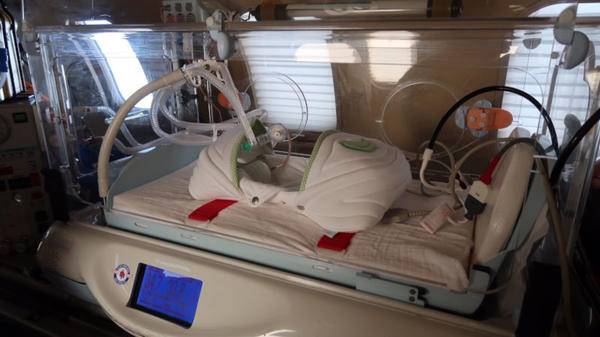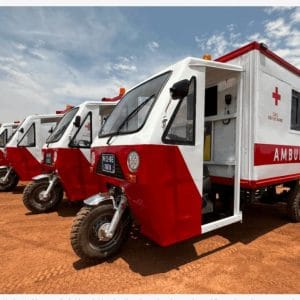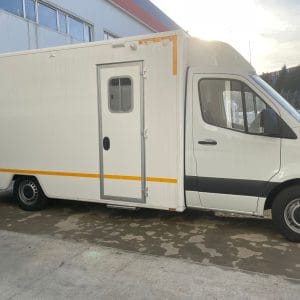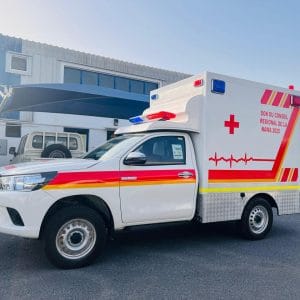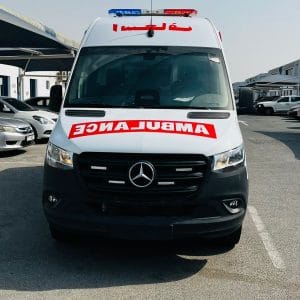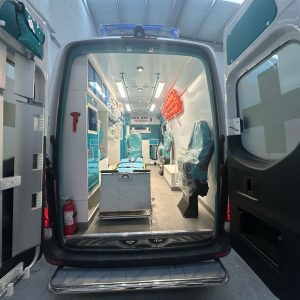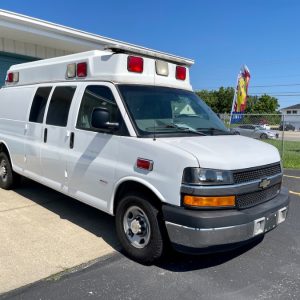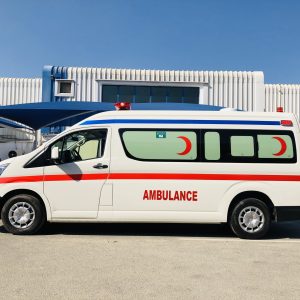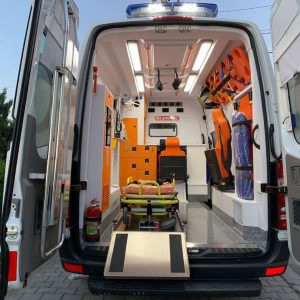Neonatal Ambulance; In critical care medicine, the first hours of a newborn’s life are the most decisive. For neonates born prematurely or with critical health complications in remote locations or smaller hospitals, the race to a specialized Neonatal Intensive Care Unit (NICU) is a race against time. A standard adult ambulance is not equipped for this delicate task. The solution is a Neonatal Ambulance—a highly specialized, mobile intensive care unit designed explicitly for the smallest and most fragile patients.
This article provides an in-depth look at the technical specifications, medical equipment, and critical design features that make a neonatal ambulance a lifeline for newborns in distress.
1. The Foundation: A Rugged and Reliable Base Vehicle
A neonatal ambulance is not just a van; it’s a platform for high-stakes medical intervention. Its base vehicle must be capable, dependable, and engineered for stability, often in challenging conditions.
- Drive Type and Chassis: The mandatory 4×4 (4WD) drive type and “Hard Terrain” designation are crucial. They ensure access to remote clinics, rural areas, or sites of complex maternal transfers, regardless of road conditions. The station wagon body style provides the necessary structural integrity and space.
- Powertrain and Performance: The heart of the vehicle is a multicylinder diesel engine with electronic fuel injection, delivering a minimum of 90 kW of power and 280 Nm of torque. This provides the robust performance needed for quick acceleration and maintaining speed on highways, all while powering significant electrical loads. The large 170-liter fuel tank ensures an extended operational range without frequent refueling.
- Safety and Handling: Safety features are paramount. The vehicle’s dimensions (Length: ~5,050mm, Wheelbase: ~2,950mm) and a tight turning radius (~6.5m) offer a blend of interior space and urban maneuverability. A high minimum ground clearance of 230mm is essential for navigating rough roads. The suspension system—coil springs with an anti-roll bar at the front and leaf springs at the rear—is tuned to provide a stable and smooth ride, minimizing vibrations that could disturb a critically ill neonate.
2. The Mobile NICU: Patient Compartment and Electrical Systems
The rear of the vehicle is transformed from a simple cargo area into a sophisticated, climate-controlled clinical environment.
2.1. The Electrical Heart: Powering Life-Support
The electrical system is the most critical non-medical component. It must be utterly reliable.
- Inverter and Batteries: A 1-5 kW inverter is installed to convert the vehicle’s DC power to AC, required for most medical devices. This is supported by appropriately sized deep-cycle lithium batteries, designed for repeated draining and recharging.
- Robust Charging and Distribution: The vehicle’s standard alternator is often upgraded to ensure it can efficiently recharge the auxiliary battery bank while the engine is running. A central distribution board with circuit breakers protects all electrical components. All wiring is properly sized, PVC-covered, and routed through fuses to prevent failures.
- Connectivity and Access: The system includes power for a two-way radio for communication with the receiving hospital and multiple 12-volt outlet sockets inside the patient compartment for additional devices.
3. Advanced Medical Equipment: The Tools for Survival
The equipment list for a neonatal ambulance reads like that of a stationary NICU, but every item is engineered for portability and resilience during transport.
3.1. The Core Life-Support System
This trio of devices creates a controlled microenvironment for the neonate.
- Advanced Neonatal Transport Incubator: This is the centerpiece. It is far more than a warmer; it’s a mobile life-support station. Key features include:
- Double-walled construction for superior temperature stability.
- A built-in humidifier to prevent delicate neonatal skin from drying out.
- Four access doors allowing medical staff to perform procedures without significant heat loss.
- Integrated oxygen cylinder rack and securing straps to keep the infant safe during movement.
- Portable Neonatal Mechanical Ventilator: For babies unable to breathe on their own, this device provides precise, mechanical breaths. It is designed to be compact, robust, and capable of delivering the very small tidal volumes required by premature infants.
- Nasal CPAP Machine: Used for infants who need help keeping their lungs open but can breathe on their own, the CPAP machine is a first-line defense against respiratory distress syndrome.
3.2. Respiratory and Gas Management
Precision in respiratory support is non-negotiable.
- Oxygen Blender and Analyzer: Pure oxygen can be harmful to a newborn’s eyes and lungs. The blender precisely mixes oxygen and medical air to deliver a specific, prescribed concentration (FiO2), which is then verified by the oxygen analyzer.
- Portable Suction Units: Both electric and manual suction machines are essential for clearing the neonate’s airway of secretions, meconium, or milk, preventing aspiration and ensuring a clear path for ventilation.
3.3. Comprehensive Monitoring and Diagnostics
Constant vigilance is maintained through an array of portable monitors.
- Multi-Parameter Patient Monitor: This device is the eyes of the medical team, continuously displaying heart rate (HR), respiratory rate (RR), temperature (Temp), blood oxygen saturation (SpO2), and non-invasive blood pressure (NBP). It uses specialized neonatal sensors and cuffs.
- End-Tidal CO2 Detector (Capnography): This critical device confirms that air is moving in and out of the lungs effectively, providing an early warning of a displaced breathing tube or worsening lung function.
- Portable Pulse Oximeter: A backup, handheld oximeter is available for spot checks or as a redundant system.
3.4. Medication and Fluid Delivery
Accurate administration of fluids and drugs is vital.
- Infusion and Syringe Pumps: These devices deliver medications, nutrients, and fluids at meticulously controlled rates. Syringe pumps are used for small, precise medication doses, while infusion pumps manage larger fluid volumes. The requirement for pumps that “accept any infusion line” ensures flexibility and compatibility with various hospital supplies.
3.5. Resuscitation and Emergency Airway Management
The ambulance must be prepared for any deterioration in the neonate’s condition.
- Emergency Trolley (Crash Cart): A fixed crash cart contains a full complement of emergency drugs, catheters, and supplies tailored for neonatal resuscitation.
- Neonatal Laryngoscopes and Airway Kit: Straight Miller blades (sizes 00, 0, 1) are used to visualize the vocal cords for intubation. This is complemented by oropharyngeal airways, self-inflating bag-valve-mask resuscitators (in sizes 0, 1, and 2), and Penguin suckers for suction.
4. The Human Element: Operational Workflow
The success of a neonatal transport relies on a highly trained team—typically a neonatal specialist doctor or a certified neonatal nurse practitioner, along a paramedic or respiratory therapist. This team operates the complex equipment, monitors the infant’s subtle physiological changes, and makes critical clinical decisions en route, all while communicating with the receiving NICU.
Conclusion: A Testament to Specialized Care
A neonatal ambulance is more than a vehicle; it is a testament to the advances in neonatal medicine and the commitment to providing every newborn with a fighting chance. By integrating a rugged, reliable 4×4 platform with a self-powered electrical system and a comprehensive suite of miniaturized, transport-ready NICU equipment, it closes the critical gap between a community hospital and a tertiary care center. It is, in every sense, a mobile NICU, bringing the highest standard of intensive care directly to the side of the most vulnerable patients, ensuring their journey to survival is as safe and stable as possible.
Frequently Asked Questions (FAQ)
Q1: Why can’t a standard ambulance be used for neonatal transport?
A1: Standard ambulances are designed for adult patients. Neonates have unique needs: they are highly susceptible to temperature loss, require miniaturized and precise medical equipment (ventilators, monitors, drug doses), and are vulnerable to vibrations and noise. A neonatal ambulance is a temperature-controlled, mobile NICU designed specifically for these challenges.
Q2: What is the purpose of the oxygen blender?
A2: Pure oxygen can be toxic to a newborn’s developing tissues, particularly the eyes and lungs. An oxygen blender precisely mixes 100% oxygen with medical air to deliver the exact, doctor-prescribed concentration the infant needs, which is often less than 100%.
Q3: Why is a 4×4 drive system so important?
A3: Many neonatal transfers originate from rural or remote hospitals with poor road infrastructure. A 4×4 system ensures the ambulance can reach these locations and complete the transport safely and without delay, regardless of weather or road conditions.
Q4: How is power supplied to all the medical equipment during transport?
A4: The ambulance has a dual electrical system. A high-output alternator charges a bank of deep-cycle lithium batteries. These batteries power a 1-5 kW inverter, which provides clean, stable AC electricity to run all the critical life-support devices independently of the vehicle’s main engine.
Q5: What is the role of the transport incubator beyond keeping the baby warm?
A5: The incubator provides a controlled microclimate. It regulates humidity to prevent dehydration, protects the infant from noise and drafts, offers physical security during movement, and has integrated ports for monitoring cables and ventilator circuits, serving as a centralized, safe platform for all care during transport.


